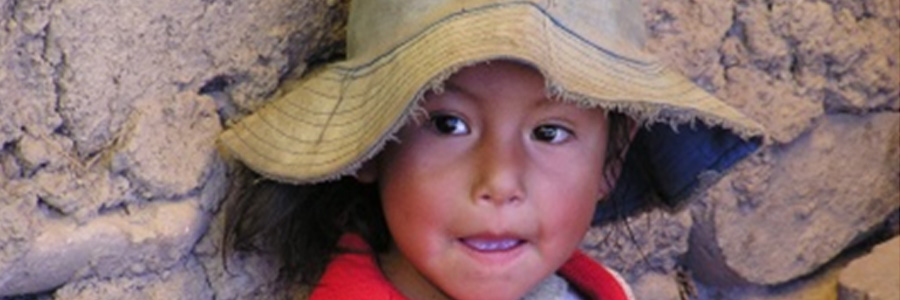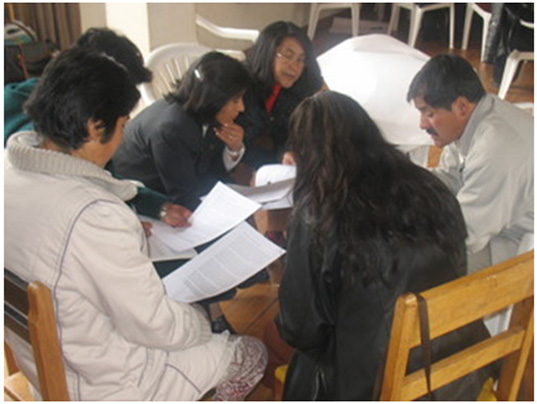Health Care for the Unreached in The Andes Highlands

The Cusco Region has among the highest rates of maternal-child mortality and chronic child malnutrition in Peru. Although the government has established primary health care facilities in these highlands, the indigenous communities do not use them due to distance and poverty combined with language and cultural barriers.
Future Generations makes 28 primary health care facilities more effective by transforming them through community participation and stronger linkages with local government.
According to Dr. Laura Altobelli, Country Director of Future Generations Peru, “The need is not only for more infrastructure, equipment, and personnel, but to strengthen the linkages between people in their homes and the existing primary health care system.”
With support from the U.S. Agency for International Development’s Child Survival and Health Grant Program (CSHGP), Future Generations began the NEXOS program.
The goal is to strengthen linkages among communities and governments working with 28 Primary Health Care facilities run by CLAS (Local Health Administration Associations) to improve health in the poorest, remotest homes.
These health facilities serve 250 communities with 112,000 people.
Eight of these 28 facilities are being strengthened into well-functioning and community-oriented “Model CLAS” to serve as regional learning and training centers.
Now in its fourth year, the NEXOS project has produced the following major results:
MOTHERS AND THEIR FAMILIES PREVENT MALNUTRITION AND ILLNESS

Health personnel at a participatory workshop for self-evaluation
NEXOS worked with 10 health facilities to carry out a self-evaluation on the organization and management, coverage, and quality of their service, with a focus on how these aspects contribute to their community-oriented work.
They then created a work plan to achieve household level changes in health and nutrition. One important change that is already being implemented is the reorganization of clinical histories from an archaic number system, to family files that are linked to each household. The result has been a change in paradigm and attitude, as health personnel begin to see Community Health Agents as an essential feature of a strong and sustainable health care system.
“This is the first time I’ve seen that health personnel are working so effectively in the communities,
and working not just in health services but also in social determinants of health, articulating the work of the health sector with other organizations and entities to work collaboratively toward meeting the needs of the community.” – Statement by Dr. Mauro Vargas, Exec.Dir., Integrated Health Care, DIRESA Cusco, during a site visit to a community in the CombapataMicroNetwork area.
COMMUNITIES ARE STRENGTHENED IN THEIR ORGANIZATION, PLANNING, AND LEADERSHIP
Leaders in 174 communities, with guidance from NEXOS and Ministry of Health staff, organized a series of public meetings and workshops to build local capacity.

Promoting Women’s Groups – Leaders of women´s groups met to exchange experiences in maternal and child health and nutrition, and to discuss their rights and responsibilities as women and mothers in the home. With a goal of 175 women leader participants, 549 attended these meetings.
Development of Community Work Plans – Teams of facilitators trained by NEXOS engaged rural communities to set their own priorities. So far, 50 Community Work Plans have been put into action, with goals such as reducing chronic child malnutrition and obtaining government funding for community projects.
Community Emergency Evacuation – Emergency Evacuation Committees are now organized in 131 out of 253 NEXOS area communities to transport obstetrical and newborn emergencies to the nearest health facility. Each committee is lead by the community leaders with participation of Community Health Agents and other volunteers who plan how to react in case a pregnant or postpartum woman, newborn, or child has a medical emergency.
Organizing Associations of Community Health Agents – NEXOS helps Community Health Agents to organize themselves into legally recognized non-profit associations that provide ownership and membership to otherwise unconnected volunteers. With an initial goal of five CHA Associations, we already have seven organized Associations. NEXOS also helps organize communities to select, support, and define the roles of their Community Health Agent.
LOCAL GOVERNMENTS HAVE STRENGTHENED CAPABILITIES FOR CO-MANAGEMENT OF HEALTH AND DEVELOPMENT OF COMMUNITIES
Advocacy efforts by Future Generations / NEXOS have resulted in a major shift in public policy with local governments becoming more involved in supporting communities and the health sector.
National Policy supports local governance -In October 2007, the Peruvian National Congress passed a law that incorporates Future Generations recommendations on restructuring and expanding CLAS.
- Local laws in Pitumarca, Checacupe, and Ccatcca require mothers and children to receive preventive health services.
- The sale of alcohol is now restricted in Chamac.
- Huaro and Ccatcca passed ordinances that strengthen recognition given to Community Health Agents.
- Local governments in Pitumarca and Ccatcca have sponsored building improvements.
- These and also that of Checacupe have constructed annex health posts in distant communities and have contracted auxiliary health personnel to work in them using municipal budgets.
- The local government of Checacupe has given Ministry of Health workers an additional salary bonus for their work done in communities.
- Local governments of Pitumarca, Checacupe, and Urcos financed training workshops for Community Health Agents.
- Pitumarca District has paid for incentives for CHA as a stimulus for their work in communities.
- Pitumarca organized a roundtable of NGOs working in the district to coordinate the external support for community health and development.
- Combapata district government has financed technical support for development of community projects to be presented to the Municipal participatory budgeting process.
- In the Districts of Quehue, Chamaca, Andahuaylillas, and Quiquijana, the local governments have requested the health facility / Futer Generations to provide them with training on the subject of co-management of health.

